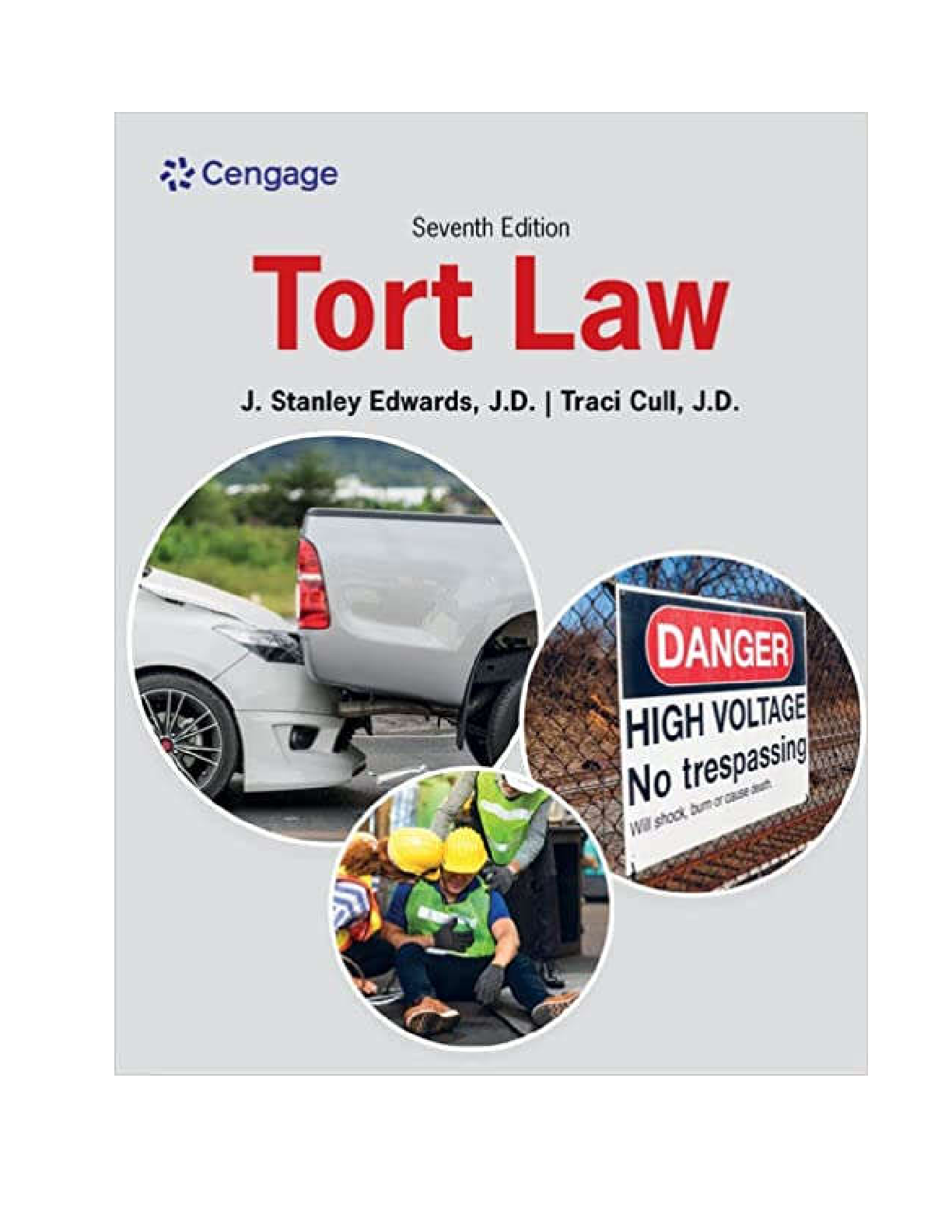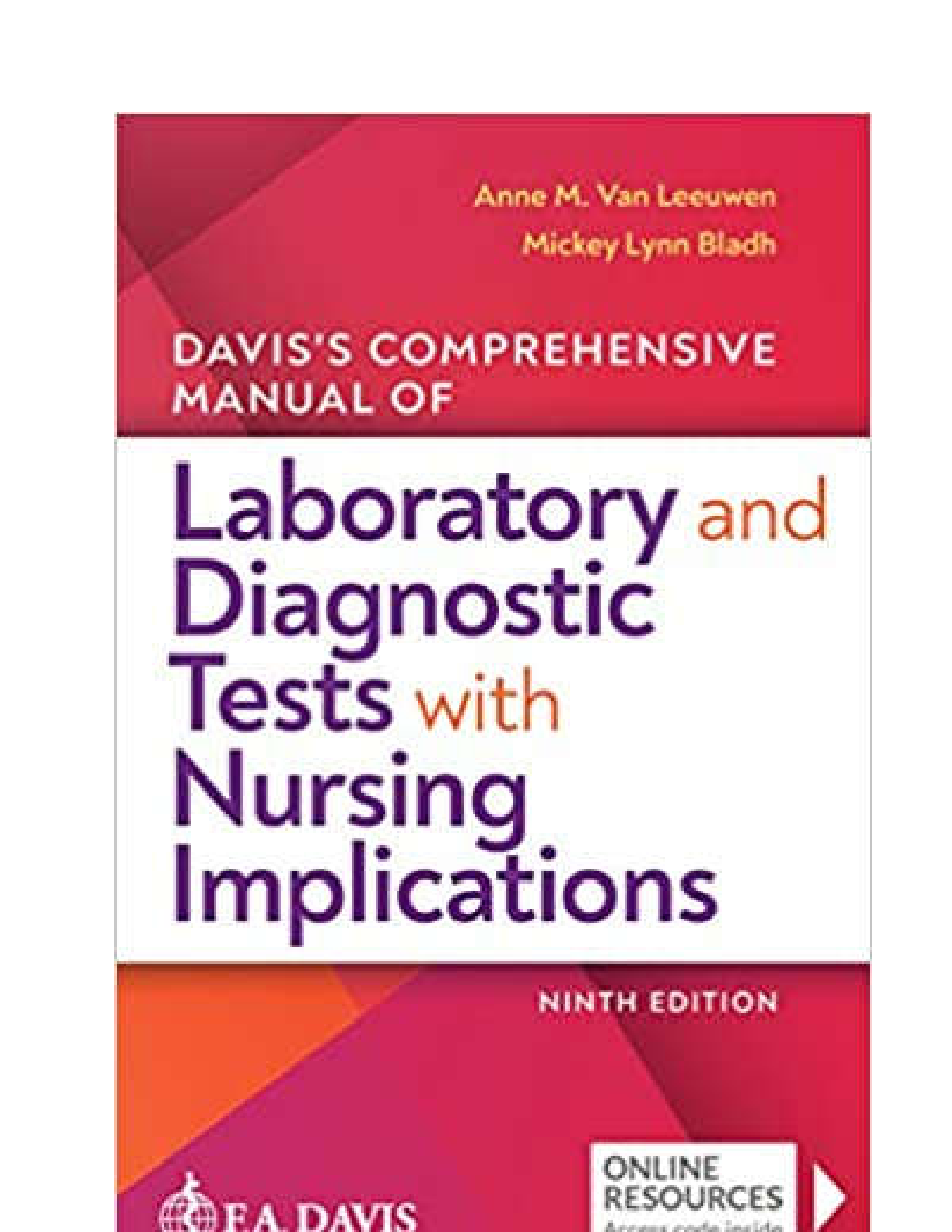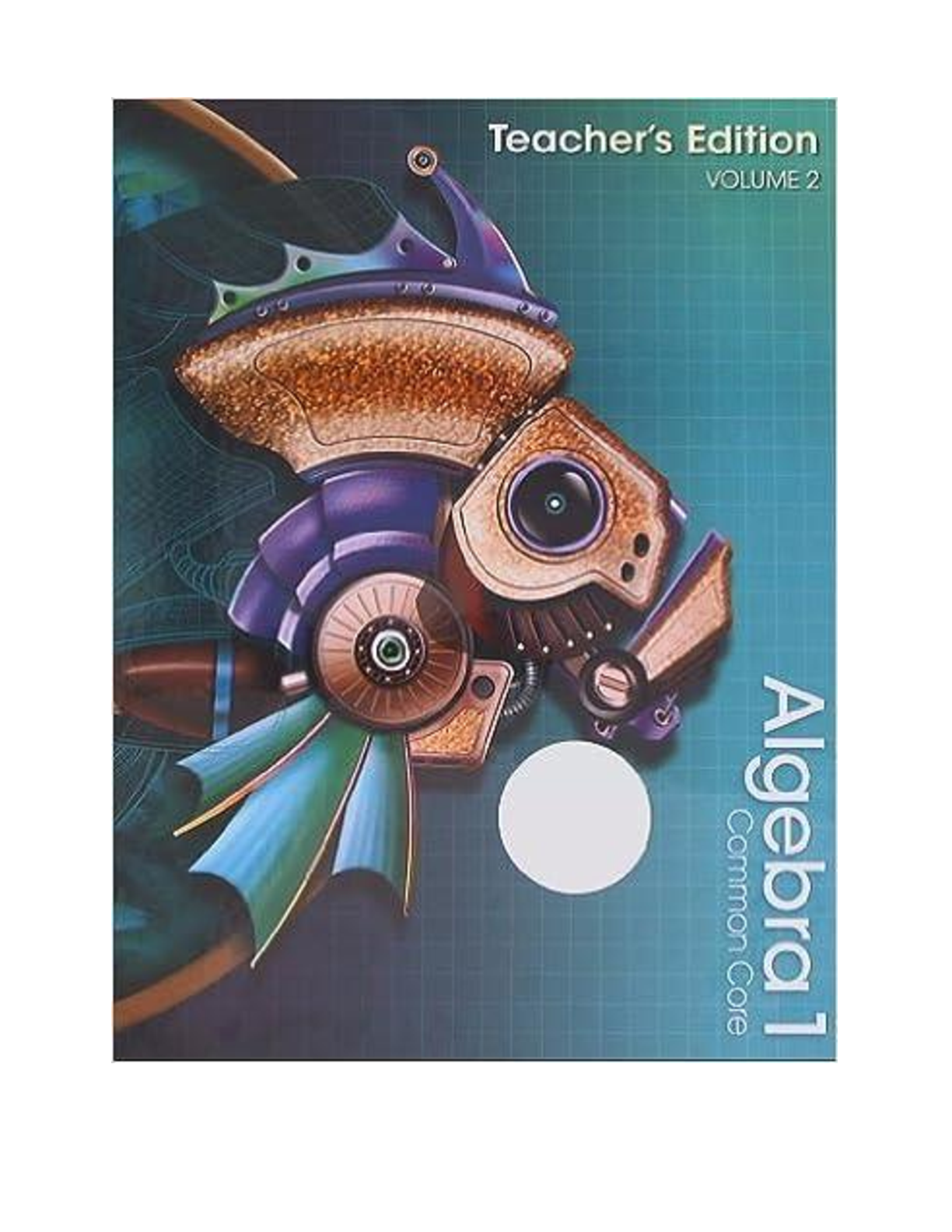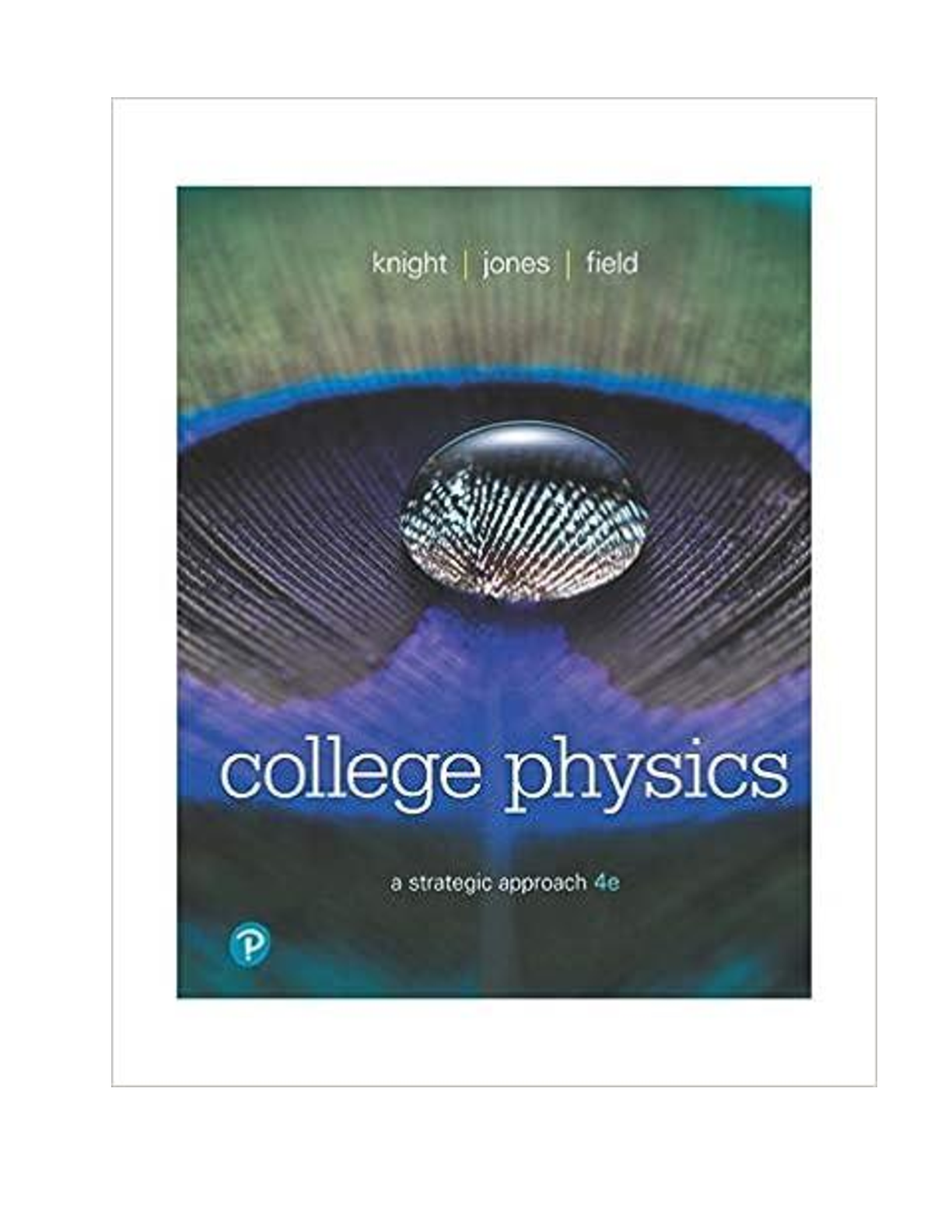Physics > eBook-PDF > eBook for College Physics A Strategic Approach 4th Edition By Randall D Knight, Brian Jones, Stuart (All)
eBook for College Physics A Strategic Approach 4th Edition By Randall D Knight, Brian Jones, Stuart Field
Document Content and Description Below
eBook for College Physics A Strategic Approach, 4th Edition By Randall D Knight, Brian Jones, Stuart Field Get all 30 chapters eBook PDF. Real-World Applications Detailed Contents Part I Force... and Motion 1 Representing Motion 1.1 Motion: A First Look Types of Motion Making a Motion Diagram 1.2 Models and Modeling The Particle Model 1.3 Position and Time: Putting Numbers on Nature Position and Coordinate Systems Time Changes in Position: Displacement Changes in Time 1.4 Velocity The “Per” in Miles Per Hour 1.5 A Sense of Scale: Significant Figures, Scientific Notation, and Units Measurements and Significant Figures Scientific Notation Units Using Prefixes Unit Conversions Between Measurement Systems Estimation 1.6 Vectors and Motion: A First Look Displacement Vectors Vector Addition Vectors and Trigonometry Velocity Vectors 1.7 Where Do We Go from Here? Summary Important Concepts Motion Diagrams Scalars and Vectors Scalar Velocity vectors Describing Motion Position Time Velocity Units Applications Working with Numbers Significant figures Questions Conceptual Questions Multiple-Choice Questions Problems 2 Motion in One Dimension 2.1 Describing Motion Representing Position Representing Velocity From Position to Velocity From Velocity to Position 2.2 Uniform Motion Equations of Uniform Motion Mathematical Relationships A Second Way to Find Position from Velocity 2.3 Instantaneous Velocity 2.4 Acceleration From Velocity to Acceleration The Sign of the Acceleration 2.5 Motion with Constant Acceleration Constant-Acceleration Equations 2.6 Solving One-Dimensional Motion Problems The Pictorial Representation The Visual Overview Problem-Solving Approach for Motion with Constant Acceleration 2.7 Free Fall Summary General Strategies Problem-Solving Approach Strategize Prepare Solve Assess Visual Overview Important Concepts Velocity Acceleration Applications Uniform Motion Motion with Constant Acceleration Free Fall Questions Conceptual Questions Multiple-Choice Questions Problems 3 Vectors and Motion in Two Dimensions 3.1 Using Vectors Vector Addition Multiplication by a Scalar Vector Subtraction 3.2 Coordinate Systems and Vector Components Coordinate Systems Component Vectors Components Working with Components Tilted Axes 3.3 Motion on a Ramp Constant-Velocity Motion on a Ramp Accelerated Motion on a Ramp 3.4 Motion in Two Dimensions Acceleration in Two Dimensions 3.5 Projectile Motion Analyzing Projectile Motion 3.6 Projectile Motion: Solving Problems The Range of a Projectile 3.7 Circular Motion 3.8 Relative Motion Relative Velocity What Comes Next: Forces Summary General Principles Projectile Motion Circular Motion Important Concepts Vectors and Components The Acceleration Vector Applications Motion on a ramp Relative motion Questions Conceptual Questions Multiple-Choice Questions Problems General Problems MCAT-Style Passage Problems Riding the Water Slide 4 Forces and Newton’s Laws of Motion 4.1 Motion and Forces What Causes Motion? Forces Force Vectors Combining Forces 4.2 A Short Catalog of Forces Weight Spring Force Tension Force Normal Force Friction Drag Thrust Electric and Magnetic Forces 4.3 Identifying Forces 4.4 What Do Forces Do? 4.5 Newton’s Second Law The Unit of Force 4.6 Free-Body Diagrams 4.7 Newton’s Third Law Interacting Objects Reasoning with Newton’s Third Law Summary General Principles Newton’s First Law Newton’s Second Law Newton’s Third Law Important Concepts Applications Identifying Forces Free-Body Diagrams Questions Conceptual Questions Multiple-Choice Questions Problems General Problems MCAT-Style Passage Problems A Simple Solution for a Stuck Car 5 Applying Newton’s Laws 5.1 Equilibrium Static Equilibrium Dynamic Equilibrium 5.2 Dynamics and Newton’s Second Law 5.3 Mass and Weight Apparent Weight Weightlessness 5.4 Normal Forces 5.5 Friction Static Friction Kinetic Friction Rolling Friction Working with Friction Forces Causes of Friction 5.6 Drag Reynolds Number Drag at High Reynolds Number Terminal Speed Drag at Low Reynolds Number Life at Low Reynolds Number (BIO) Catalog of Forces Revisited 5.7 Interacting Objects Objects in Contact 5.8 Ropes and Pulleys Pulleys Summary General Strategy Equilibrium Problems Strategize Prepare Solve Assess Dynamics Problems Strategize Prepare Solve Assess Important Concepts Applications Questions Conceptual Questions Multiple-Choice Questions Problems 6 Circular Motion, Orbits, and Gravity 6.1 Uniform Circular Motion Velocity and Acceleration in Uniform Circular Motion Period, Frequency, and Speed 6.2 Dynamics of Uniform Circular Motion Maximum Walking Speed (BIO) 6.3 Apparent Forces in Circular Motion Centrifugal Force? Apparent Weight in Circular Motion Centrifuges (BIO) 6.4 Circular Orbits and Weightlessness Orbital Motion Weightlessness in Orbit The Orbit of the Moon 6.5 Newton’s Law of Gravity Gravity Obeys an Inverse-Square Law Gravity on Other Worlds 6.6 Gravity and Orbits Gravity on a Grand Scale Summary General Principles Uniform Circular Motion Universal Gravitation Important Concepts Describing Circular Motion Planetary Gravity Applications Apparent Weight and Weightlessness Orbital Motion Questions Conceptual Questions Multiple-Choice Questions Problems 7 Rotational Motion 7.1 Describing Circular and Rotational Motion Angular Position Angular Displacement and Angular Velocity Angular-Position and Angular-Velocity Graphs Relating Speed and Angular Speed 7.2 The Rotation of a Rigid Body Angular Acceleration Graphs for Rotational Motion with Constant Angular Acceleration Tangential Acceleration 7.3 Torque Net Torque 7.4 Gravitational Torque and the Center of Gravity Calculating the Position of the Center of Gravity 7.5 Rotational Dynamics and Moment of Inertia Newton’s Second Law for Rotation Interpreting the Moment of Inertia The Moments of Inertia of Common Shapes 7.6 Using Newton’s Second Law for Rotation Constraints Due to Ropes and Pulleys 7.7 Rolling Motion Summary General Principles Newton’s Second Law for Rotational Motion Important Concepts Describing Circular Motion Relating Linear and Circular Motion Quantities Torque Center of Gravity Applications Moments of Inertia of Common Shapes Rotation about a Fixed Axis Rolling Motion Questions Conceptual Questions Multiple-Choice Questions Problems 8 Equilibrium and Elasticity 8.1 Torque and Static Equilibrium Choosing the Pivot Point 8.2 Stability and Balance Stability and Balance of the Human Body (BIO) 8.3 Springs and Hooke’s Law 8.4 Stretching and Compressing Materials Beyond the Elastic Limit Elasticity of Biological Materials (BIO) 8.5 Forces and Torques in the Body (BIO) Mechanical Advantage Strength Versus Range of Motion and Speed Summary General Principles Static Equilibrium Springs and Hooke’s Law Important Concepts Stability Elastic materials and Young’s modulus Applications Forces and torques in the body The elastic limit and beyond Questions Conceptual Questions Multiple-Choice Questions Problems Part I Summary Force and Motion Knowledge Structure I Force and Motion Basic Goals Cross-Cutting Concepts General Principles Kinematics Dynamics Rigid bodies Torque and rotational dynamics Rotation about a fixed axis Part I Problems Animal Athletes (BIO) Sticky Liquids (BIO) Pulling Out of a Dive (BIO) Bending Beams Additional Integrated Problems Part II Conservation Laws 9 Momentum 9.1 Impulse 9.2 Momentum and the Impulse-Momentum Theorem Momentum The Impulse-Momentum Theorem Total Momentum 9.3 Solving Impulse and Momentum Problems The Impulse Approximation 9.4 Conservation of Momentum Law of Conservation of Momentum It Depends on the System Explosions 9.5 Inelastic Collisions 9.6 Momentum and Collisions in Two Dimensions 9.7 Angular Momentum Conservation of Angular Momentum Varying Moment of Inertia Summary General Principles Conservation Laws Conservation of momentum Conservation of angular momentum Solving Momentum Conservation Problems Strategize Prepare Solve Assess Important Concepts Momentum Impulse Angular momentum System Isolated system Before-and-after visual overview Applications Collisions Explosions Two dimensions Questions Conceptual Questions Multiple-Choice Questions Problems 10 Energy and Work 10.1 The Basic Energy Model Systems and Forms of Energy Energy Transformations Energy Transfers and Work The Law of Conservation of Energy 10.2 Work Work by Forces at an Angle to the Displacement Forces That Do No Work 10.3 Kinetic Energy Translational Kinetic Energy Rotational Kinetic Energy 10.4 Potential Energy Gravitational Potential Energy Elastic Potential Energy 10.5 Thermal Energy 10.6 Conservation of Energy Using the Law of Conservation of Energy 10.7 Energy Diagrams Interpreting Energy Diagrams Equilibrium Positions 10.8 Molecular Bonds and Chemical Energy Chemical Reactions Reaction Rates and Catalysts Chemical Energy 10.9 Energy in Collisions Elastic Collisions 10.10 Power Summary General Principles Basic Energy Model Conservation of Energy Solving Energy Transfer and Energy Conservation Problems Important Concepts Applications Questions Conceptual Questions Multiple-Choice Questions Problems General Problems MCAT-Style Passage Problems Tennis Ball Testing Work and Power in Cycling 11 Using Energy 11.1 Transforming Energy Efficiency 11.2 Energy in the Body (BIO) Getting Energy from Food: Energy Inputs Using Energy in the Body: Energy Outputs Efficiency of the Human Body Energy Storage Energy and Locomotion 11.3 Temperature, Thermal Energy, and Heat Relating Thermal Energy and Temperature Temperature Scales What Is Heat? An Atomic Model of Heat 11.4 The First Law of Thermodynamics Energy-Transfer Diagrams 11.5 Heat Engines 11.6 Heat Pumps 11.7 Entropy and the Second Law of Thermodynamics Reversible and Irreversible Processes Thermal Energy Spreads Entropy Reasoning with Entropy 11.8 Systems, Energy, and Entropy The Conservation of Energy and Energy Conservation Entropy and Life (BIO) Entropy, Free Energy, and Spontaneity Summary General Principles Energy and Efficiency Entropy and Irreversibility The Laws of Thermodynamics Important Concepts Applications Questions Conceptual Questions Multiple-Choice Questions Problems General Problems MCAT-Style Passage Problems Kangaroo Locomotion (BIO) Animal Power Part II Summary Conservation Laws Knowledge Structure II Conservation Laws Basic Goals Cross-Cutting Concepts General Principles Basic Problem-Solving Approach Momentum and impulse Basic model of energy Limitations on energy transfers and transformations Momentum Energy Relating Force and Momentum Work-Energy Equation Power Part II Problems Big Air Testing Tennis Balls Squid Propulsion (BIO) Teeing Off Additional Integrated Problems Part III Properties of Matter 12 Thermal Properties of Matter 12.1 The Atomic Model of Matter Atomic Mass and Atomic Mass Number The Definition of the Mole Volume 12.2 The Atomic Model of an Ideal Gas Molecular Speeds and Temperature Pressure The Ideal-Gas Law 12.3 Ideal-Gas Processes pV Diagrams Constant-Volume Processes Constant-Pressure Processes Constant-Temperature Processes Thermodynamics of Ideal-Gas Processes Adiabatic Processes 12.4 Thermal Expansion 12.5 Specific Heat and Heat of Transformation Specific Heat Phase Changes Heat of Transformation Evaporation 12.6 Calorimetry 12.7 Specific Heats of Gases 12.8 Heat Transfer Conduction Convection Radiation 12.9 Diffusion Fick’s Law Summary General Principles Atomic Model Atomic Model of a Gas Ideal-Gas Law Important Concepts Effects of Heat Transfer Mechanisms of Heat Transfer Diffusion Applications Thermal Expansion Calorimetry Questions Conceptual Questions Multiple-Choice Questions Problems 13 Fluids 13.1 Fluids and Density Density 13.2 Pressure Pressure in Liquids Atmospheric Pressure Measuring Atmospheric Pressure Pressure Units 13.3 Buoyancy Float or Sink? Boats and Balloons Buoyancy and Bodies (BIO) 13.4 Fluids in Motion The Role of Viscosity The Equation of Continuity Representing Fluid Flow: Streamlines and Fluid Elements 13.5 Fluid Dynamics Applications of the Bernoulli Effect Bernoulli’s Equation 13.6 Viscosity and Poiseuille’s Equation Poiseuille’s Equation 13.7 The Circulatory System (BIO) Blood Pressure The Arteries and Capillaries The Veins Summary General Principles Fluid Statics Gases Liquids Fluid Dynamics Equation of Continuity Bernoulli’s Equation Poiseuille’s Equation Important Concepts Density Pressure Viscosity Representing Fluid Flow Applications Buoyancy Archimedes’ Principle Barometers Questions Conceptual Questions Multiple-Choice Questions Problems General Problems MCAT-Style Passage Problems Blood Pressure and Blood Flow (BIO) Part III Summary Properties of Matter Knowledge Structure III Properties of Matter Basic Goals Cross-Cutting Concepts Flows of Energy and Matter General Principles Phases of Matter Fluids and Pressure Ideal-Gas Processes Heat and Heat Transfer Fluid Statics Fluid Flow Part III Problems Keeping Your Cool (BIO) Weather Balloons Passenger Balloons Additional Integrated Problems Part IV Oscillations and Waves 14 Oscillations 14.1 Equilibrium and Oscillation Frequency and Period Simple Harmonic Motion 14.2 Linear Restoring Forces and SHM Horizontal Motion of a Mass on a Spring Vertical Motion of a Mass on a Spring The Pendulum 14.3 Describing Simple Harmonic Motion Connecting SHM to Uniform Circular Motion 14.4 Energy in Simple Harmonic Motion Finding the Frequency for Simple Harmonic Motion 14.5 Pendulum Motion Physical Pendulums and Locomotion 14.6 Damped Oscillations 14.7 Driven Oscillations and Resonance Resonance and Hearing (BIO) Summary General Principles Frequency and Period Energy Important Concepts Oscillation Simple Harmonic Motion (SHM) Applications Damping Resonance Physical pendulum Questions Conceptual Questions Multiple-Choice Questions Problems 15 Traveling Waves and Sound 15.1 The Wave Model Mechanical Waves Electromagnetic and Matter Waves Transverse and Longitudinal Waves 15.2 Traveling Waves Waves on a String Sound Waves Wave Speed Is a Property of the Medium 15.3 Graphical and Mathematical Descriptions of Waves Snapshot and History Graphs The Mathematical Description of Sinusoidal Waves The Fundamental Relationship for Sinusoidal Waves 15.4 Sound and Light Waves Sound Waves Light and Other Electromagnetic Waves 15.5 Energy and Intensity Circular, Spherical, and Plane Waves Power, Energy, and Intensity 15.6 Loudness of Sound The Decibel Scale 15.7 The Doppler Effect and Shock Waves Sound Waves from a Moving Source A Stationary Source and a Moving Observer The Doppler Effect for Light Waves Frequency Shift on Reflection from a Moving Object Shock Waves Summary General Principles The Wave Model Mechanical Waves Electromagnetic Waves Important Concepts Graphical Representation of Waves Mathematical Representation of Waves Sinusoidal waves Applications Questions Conceptual Questions Multiple-Choice Questions Problems 16 Superposition and Standing Waves 16.1 The Principle of Superposition Constructive and Destructive Interference 16.2 Standing Waves Superposition Creates a Standing Wave Nodes and Antinodes 16.3 Standing Waves on a String Reflections Creating a Standing Wave The Fundamental Frequency and Higher Harmonics Stringed Musical Instruments Standing Electromagnetic Waves 16.4 Standing Sound Waves Wind Instruments 16.5 Speech and Hearing (BIO) The Frequency Spectrum Vowels and Formants 16.6 The Interference of Waves from Two Sources Interference Along a Line Interference of Spherical Waves 16.7 Beats Summary General Principles Principle of Superposition Interference Important Concepts Standing Waves Applications Beats Questions Conceptual Questions Multiple-Choice Questions Problems Part IV Summary Oscillations and Waves Knowledge Structure IV Basic Goals Cross-Cutting Consepts General Principles Simple harmonic motion Traveling waves Superposition and Interference Standing Waves Part IV Problems Deep-Water Waves Attenuation of Ultrasound (BIO) Measuring the Speed of Sound In the Swing Additional Integrated Problems Part V Optics 17 Wave Optics 17.1 What Is Light? The Propagation of Light Waves Light Is an Electromagnetic Wave The Index of Refraction 17.2 The Interference of Light Young’s Double-Slit Experiment Analyzing Double-Slit Interference 17.3 The Diffraction Grating Spectroscopy Reflection Gratings 17.4 Thin-Film Interference Interference of Reflected Light Waves Structural Color from Thin Films 17.5 Single-Slit Diffraction Huygens’ Principle Analyzing Single-Slit Diffraction The Width of a Single-Slit Diffraction Pattern 17.6 Circular-Aperture Diffraction Summary General Principles The Wave Model Huygens’ principle Important Concepts Diffraction Applications Diffraction from a Single Slit Interference from Multiple Slits Double Slit Diffraction Grating Circular Aperture Thin-Film Interference Questions Conceptual Questions Multiple-Choice Questions Problems 18 Ray Optics 18.1 The Ray Model of Light Sources of Light Rays Ray Diagrams Seeing Objects Shadows 18.2 Reflection Diffuse Reflection The Plane Mirror 18.3 Refraction Examples of Refraction Total Internal Reflection Fiber Optics 18.4 Image Formation by Refraction 18.5 Thin Lenses: Ray Tracing Converging Lenses Real Images Magnification Virtual Images Diverging Lenses 18.6 Image Formation with Spherical Mirrors Converging Mirrors Diverging Mirrors 18.7 The Thin-Lens Equation Sign Conventions for Lenses and Mirrors Summary General Principles Reflection Refraction Important Concepts The ray model of light Image formation Applications Ray tracing for lenses Ray tracing for mirrors The thin-lens equation Questions Conceptual Questions Multiple-Choice Questions Problems General Problems MCAT-Style Passage Problems Mirages 19 Optical Instruments 19.1 The Camera 19.2 The Human Eye (BIO) Refractive Power The Optical System of the Eye Focusing and Accommodation Presbyopia Myopia and Hyperopia Other Types of Vision Correction and Vision Enhancement 19.3 The Magnifier Angular Size and Apparent Size Using a Magnifier 19.4 The Microscope 19.5 The Telescope 19.6 Color and Dispersion Color Dispersion Rainbows Colored Filters and Colored Objects 19.7 Resolution of Optical Instruments Aberrations Correcting Aberrations Resolution and the Wave Nature of Light The Resolution of a Microscope Summary Important Concepts Lenses in combination Resolution of optical instruments Color and dispersion Angular and apparent size Applications The camera and the eye The telescope The magnifier The microscope Questions Conceptual Questions Multiple-Choice Questions Problems General Problems MCAT-Style Passage Problems Surgical Vision Correction (BIO) Part V Summary Optics Knowledge Structure V Basic Goals Cross-Cutting Concepts: The Nature of Light General Principles: Models of Light Wave model The resolution of optical instruments Ray model Image formation by lenses and mirrors Part V Problems Horse Sense (BIO) Mirror Eyes (BIO) Pupil Size (BIO) Additional Integrated Problems Part VI Electricity and Magnetism 20 Electric Fields and Forces 20.1 Charges and Forces Experimenting with Charges Visualizing Charge Insulators and Conductors Polarization 20.2 Charges, Atoms, and Molecules An Atomic View of Charging Charge Conservation Insulators and Conductors Electric Dipoles Hydrogen Bonding 20.3 Coulomb’s Law Using Coulomb’s Law 20.4 The Concept of the Electric Field The Electric Field Is Real The Field Model The Electric Field of a Point Charge 20.5 The Electric Field of Multiple Charges Uniform Electric Fields Electric Field Lines The Electric Field of the Heart (BIO) 20.6 Conductors and Electric Fields 20.7 Forces and Torques in Electric Fields Summary General Principles Charge Coulomb’s Law Important Concepts The Electric Field Visualizing the electric field Applications Electric fields: important cases Conductors in electric fields Questions Conceptual Questions Multiple-Choice Questions Problems General Problems MCAT-Style Passage Problems Flow Cytometry (BIO) 21 Electric Potential 21.1 Electric Potential Energy and Electric Potential Electric Potential Energy Electric Potential 21.2 Sources of Electric Potential Measuring Electric Potential Is High Voltage Dangerous? 21.3 Electric Potential and Conservation of Energy The Electron Volt 21.4 Calculating the Electric Potential The Electric Potential Inside a Parallel-Plate Capacitor The Electric Potential of a Point Charge The Electric Potential of a Charged Sphere Ionization Energy The Electric Potential of Many Charges 21.5 Connecting Potential and Field A Conductor in Electrostatic Equilibrium 21.6 The Electrocardiogram (BIO) 21.7 Capacitance and Capacitors Charging a Capacitor The Parallel-Plate Capacitor Dielectrics and Capacitors 21.8 Energy and Capacitors The Energy in the Electric Field Summary General Principles Electric Potential and Potential Energy Sources of Potential Connecting potential and field Important Concepts Graphical representations of the potential Applications Capacitors and dielectrics Parallel-plate capacitor Units Questions Conceptual Questions Multiple-Choice Questions Problems General Problems MCAT-Style Passage Problems A Lightning Strike 22 Current and Resistance 22.1 A Model of Current Creating a Current Conservation of Current 22.2 Defining and Describing Current Definition of Current Conservation of Current at a Junction 22.3 Batteries and emf 22.4 Connecting Potential and Current Resistance Resistivity Electrical Measurements of Physical Properties 22.5 Ohm’s Law and Resistor Circuits Resistors Analyzing a Simple Circuit 22.6 Energy and Power Summary General Principles Batteries, Resistors, and Current Important Concepts Applications Questions Conceptual Questions Multiple-Choice Questions Problems General Problems MCAT-Style Passage Problems Lightbulb Failure 23 Circuits 23.1 Circuit Elements and Diagrams 23.2 Kirchhoff’s Laws 23.3 Series and Parallel Circuits Series Resistors Parallel Resistors 23.4 Measuring Voltage and Current 23.5 More Complex Circuits 23.6 Capacitors in Parallel and Series 23.7 RC Circuits Discharging a Capacitor Charging a Capacitor 23.8 Electricity in the Nervous System (BIO) The Electrical Nature of Nerve Cells The Action Potential The Propagation of Nerve Impulses Increasing Nerve-Impulse Speed by Insulation Summary General Principles Analyzing Circuits Important Concepts Applications Questions Conceptual Questions Multiple-Choice Questions Problems General Problems MCAT-Style Passage Problems The Defibrillator (BIO) Electric Fish (BIO) (INT) 24 Magnetic Fields and Forces 24.1 Magnetism 24.2 The Magnetic Field Measuring the Magnetic Field Magnetic Field Vectors and Field Lines The Magnetic Field of the Earth 24.3 Electric Currents Also Create Magnetic Fields The Magnetic Field of a Straight, Current-Carrying Wire The Magnetic Field of a Current Loop The Magnetic Field of a Solenoid 24.4 Calculating the Magnetic Field Due to a Current Wires Magnetic Fields from More Than One Source Current Loops Solenoids 24.5 Magnetic Fields Exert Forces on Moving Charges Paths of Charged Particles in Magnetic Fields The Cyclotron Electromagnetic Flowmeters 24.6 Magnetic Fields Exert Forces on Currents The Form of the Magnetic Force on a Current Forces Between Currents Forces Between Current Loops 24.7 Magnetic Fields Exert Torques on Dipoles A Current Loop in a Uniform Field Magnetic Resonance Imaging (MRI) Electric Motors 24.8 Magnets and Magnetic Materials Ferromagnetism Induced Magnetic Moments Electromagnets Summary General Principles Sources of Magnetism Consequences of Magnetism Important Concepts Magnetic Fields Magnetic Forces and Torques Applications Questions Conceptual Questions Multiple-Choice Questions Problems General Problems MCAT-Style Passage Problems The Velocity Selector (INT) Ocean Potentials (INT) The Mass Spectrometer 25 EM Induction and EM Waves 25.1 Induced Currents 25.2 Motional emf Induced Current in a Circuit Energy Considerations Generators 25.3 Magnetic Flux and Lenz’s Law Magnetic Flux Lenz’s Law 25.4 Faraday’s Law Eddy Currents 25.5 Electromagnetic Waves Induced Fields Properties of Electromagnetic Waves Polarization Energy of Electromagnetic Waves Polarizers and Changing Polarization 25.6 The Photon Model of Electromagnetic Waves 25.7 The Electromagnetic Spectrum Radio Waves and Microwaves Infrared, Visible Light, and Ultraviolet Color Vision X Rays and Gamma Rays Summary General Principles Electromagnetic Induction Electromagnetic Waves Important Concepts Applications Questions Conceptual Questions Multiple-Choice Questions Problems General Problems MCAT-Style Passage Problems Electromagnetic Wave Penetration (BIO) The Metal Detector 26 AC Electricity 26.1 Alternating Current Resistor Circuits AC Power in Resistors 26.2 AC Electricity and Transformers Transformer Operation Power Transmission 26.3 Household Electricity Electric Outlets Are Grounded Parallel Circuits Kilowatt Hours 26.4 Biological Effects and Electrical Safety (BIO) GFI Circuits 26.5 Capacitor Circuits Capacitive Reactance 26.6 Inductors and Inductor Circuits Inductance Inductor Circuits Inductive Reactance 26.7 Oscillation Circuits LC Circuits RLC Circuits Summary Important Concepts AC circuits Power in AC resistor circuits Circuit elements used in AC circuits Electrical safety and biological effects Applications Transformers LC and RLC circuits The driven RLC circuit Questions Conceptual Questions Multiple-Choice Questions Problems Section 26.1 Alternating Current Section 26.2 AC Electricity and Transformers Section 26.3 Household Electricity Section 26.4 Biological Effects and Electrical Safety Section 26.5 Capacitor Circuits Section 26.6 Inductors and Inductor Circuits Section 26.7 Oscillation Circuits General Problems MCAT-Style Passage Problems Cell Membrane Capacitance (BIO) Halogen Bulbs Part VI Summary Electricity and Magnetism Knowledge Structure VI Basic Goals Cross-Cutting Concepts General Principles Electric fields and forces Electric potential Magnetic fields Electromagnetic waves Current and circuits Part VI Problems Taking an X Ray (BIO) Electric Cars Wireless Power Transmission Additional Integrated Problems Part VII Modern Physics 27 Relativity 27.1 Relativity: What’s It All About? What’s Special, and What’s Relative, About Special Relativity? 27.2 Galilean Relativity Reference Frames Inertial Reference Frames The Galilean Velocity Transformation 27.3 Einstein’s Principle of Relativity The Constancy of the Speed of Light How Can This Be? 27.4 Events and Measurements Events Measurements Clock Synchronization Events and Observations Simultaneity 27.5 The Relativity of Simultaneity 27.6 Time Dilation Proper Time The Evidence from Cosmic Rays The Twin Paradox 27.7 Length Contraction The Binomial Approximation 27.8 Velocities of Objects in Special Relativity 27.9 Relativistic Momentum The Cosmic Speed Limit 27.10 Relativistic Energy The Equivalence of Mass and Energy Conservation of Energy Summary General Principles Principle of Relativity Important Concepts Time Momentum Simultaneity Space Energy Mass-energy equivalence Applications Questions Conceptual Questions Multiple-Choice Questions Problems General Problems MCAT-Style Passage Problems Pion Therapy BIO 28 Quantum Physics 28.1 X Rays and X-Ray Diffraction X-Ray Images (BIO) X-Ray Diffraction 28.2 The Photoelectric Effect Characteristics of the Photoelectric Effect Understanding the Photoelectric Effect Einstein’s Explanation Einstein’s Postulates and the Photoelectric Effect 28.3 Photons The Photon Rate Detecting Photons 28.4 Matter Waves The Interference and Diffraction of Matter The Electron Microscope 28.5 Energy Is Quantized 28.6 Energy Levels and Quantum Jumps Energy-Level Diagrams 28.7 The Uncertainty Principle 28.8 Applications and Implications of Quantum Theory Tunneling and the Scanning Tunneling Microscope Wave–Particle Duality Summary General Principles Important Concepts Photoelectric effect X-ray diffraction Energy levels and quantum jumps Applications Questions Conceptual Questions Multiple-Choice Questions Problems General Problems MCAT-Style Passage Problems Compton Scattering Electron Diffraction Collisional Excitation 29 Atoms and Molecules 29.1 Spectroscopy 29.2 Atoms The First Nuclear Physics Experiment Using the Nuclear Model 29.3 Bohr’s Model of Atomic Quantization 29.4 The Bohr Hydrogen Atom The Stationary States of the Hydrogen Atom Hydrogen Atom Energy Levels The Hydrogen Spectrum 29.5 The Quantum-Mechanical Hydrogen Atom Energy and Angular Momentum Are Quantized The Electron Spin 29.6 Multi-electron Atoms The Pauli Exclusion Principle The Periodic Table of the Elements 29.7 Excited States and Spectra Excitation by Absorption Collisional Excitation Emission Spectra X Rays 29.8 Molecules 29.9 Stimulated Emission and Lasers Lasers Lasers in Medicine Summary Important Concepts The Structure of an Atom The Bohr Atom The Hydrogen Atom Applications Atomic emission spectra Lasers Questions Conceptual Questions Multiple-Choice Questions Problems General Problems MCAT-Style Passage Problems Light-Emitting Diodes The Spectrum of Singly Ionized Helium Muonic Hydrogen 30 Nuclear Physics 30.1 Nuclear Structure Isotopes Atomic Mass 30.2 Nuclear Stability Binding Energy 30.3 Forces and Energy in the Nucleus Low-Z Nuclei High-Z Nuclei 30.4 Radiation and Radioactivity Alpha Decay Beta Decay Gamma Decay Decay Series Nuclear Radiation Is a Form of Ionizing Radiation (BIO) 30.5 Nuclear Decay and Half-Lives Activity Radioactive Dating 30.6 Medical Applications of Nuclear Physics (BIO) Radiation Dose Sources of Radiation and Its Effects Nuclear Medicine Nuclear Imaging Positron-Emission Tomography 30.7 The Ultimate Building Blocks of Matter Antiparticles Neutrinos Quarks Fundamental Particles Summary General Principles The Nucleus Nuclear Stability Important Concepts Applications Questions Conceptual Questions Multiple-Choice Questions Problems General Problems MCAT-Style Passage Problems Plutonium-Powered Exploration (BIO) Nuclear Fission Part VII Summary Modern Physics Knowledge Structure VII Basic Goals Cross-Cutting Concepts The nature of matter Quantum states of electrons, neutrons, and protons General Principles Relativity Quantum physics Properties of atoms Properties of nuclei Part VII Problems Splitting the Atom Detecting and Deciphering Radiation Additional Integrated Problems Appendix A Mathematics Review Algebra Geometry and Trigonometry Expansions and Approximations Appendix B Periodic Table of Elements Appendix C Atomic and Nuclear Data Answers Chapter 1 Answers to odd-numbered multiple-choice questions Answers to odd-numbered problems Chapter 2 Answers to odd-numbered multiple-choice questions Answers to odd-numbered problems Chapter 3 Answers to odd-numbered multiple-choice questions Answers to odd-numbered problems Chapter 4 Answers to odd-numbered multiple-choice questions Answers to odd-numbered problems Chapter 5 Answers to odd-numbered multiple-choice questions Answers to odd-numbered problems Chapter 6 Answers to odd-numbered multiple-choice questions Answers to odd-numbered problems Chapter 7 Answers to odd-numbered multiple-choice questions Answers to odd-numbered problems Chapter 8 Answers to odd-numbered multiple-choice questions Answers to odd-numbered problems Part I Problems Answers to odd-numbered problems Chapter 9 Answers to odd-numbered multiple-choice questions Answers to odd-numbered problems Chapter 10 Answers to odd-numbered multiple-choice questions Answers to odd-numbered problems Chapter 11 Answers to odd-numbered multiple-choice questions Answers to odd-numbered problems Part II Problems Answers to odd-numbered problems Chapter 12 Answers to odd-numbered multiple-choice questions Answers to odd-numbered problems Chapter 13 Answers to odd-numbered multiple-choice questions Answers to odd-numbered problems Part III Problems Answers to odd-numbered problems Chapter 14 Answers to odd-numbered multiple-choice questions Answers to odd-numbered problems Chapter 15 Answers to odd-numbered multiple-choice questions Answers to odd-numbered problems Chapter 16 Answers to odd-numbered multiple-choice questions Answers to odd-numbered problems Part IV Problems Answers to odd-numbered problems Chapter 17 Answers to odd-numbered multiple-choice questions Answers to odd-numbered problems Chapter 18 Answers to odd-numbered multiple-choice questions Answers to odd-numbered problems Chapter 19 Answers to odd-numbered multiple-choice questions Answers to odd-numbered problems Part V Problems Answers to odd-numbered problems Chapter 20 Answers to odd-numbered multiple-choice questions Answers to odd-numbered problems Chapter 21 Answers to odd-numbered multiple-choice questions Answers to odd-numbered problems Chapter 22 Answers to odd-numbered multiple-choice questions Answers to odd-numbered problems Chapter 23 Answers to odd-numbered multiple-choice questions Answers to odd-numbered problems Chapter 24 Answers to odd-numbered multiple-choice questions Answers to odd-numbered problems Chapter 25 Answers to odd-numbered multiple-choice questions Answers to odd-numbered problems Chapter 26 Answers to odd-numbered multiple-choice questions Answers to odd-numbered problems Part VI Problems Answers to odd-numbered problems Chapter 27 Answers to odd-numbered multiple-choice questions Answers to odd-numbered problems Chapter 28 Answers to odd-numbered multiple-choice questions Answers to odd-numbered problems Chapter 29 Answers to odd-numbered multiple-choice questions Answers to odd-numbered problems Chapter 30 Answers to odd-numbered multiple-choice questions Answers to odd-numbered problems Part VII Problems Answers to odd-numbered problems Credits Index [Show More]
Last updated: 1 week ago
Preview 1 out of 1160 pages
Instant download
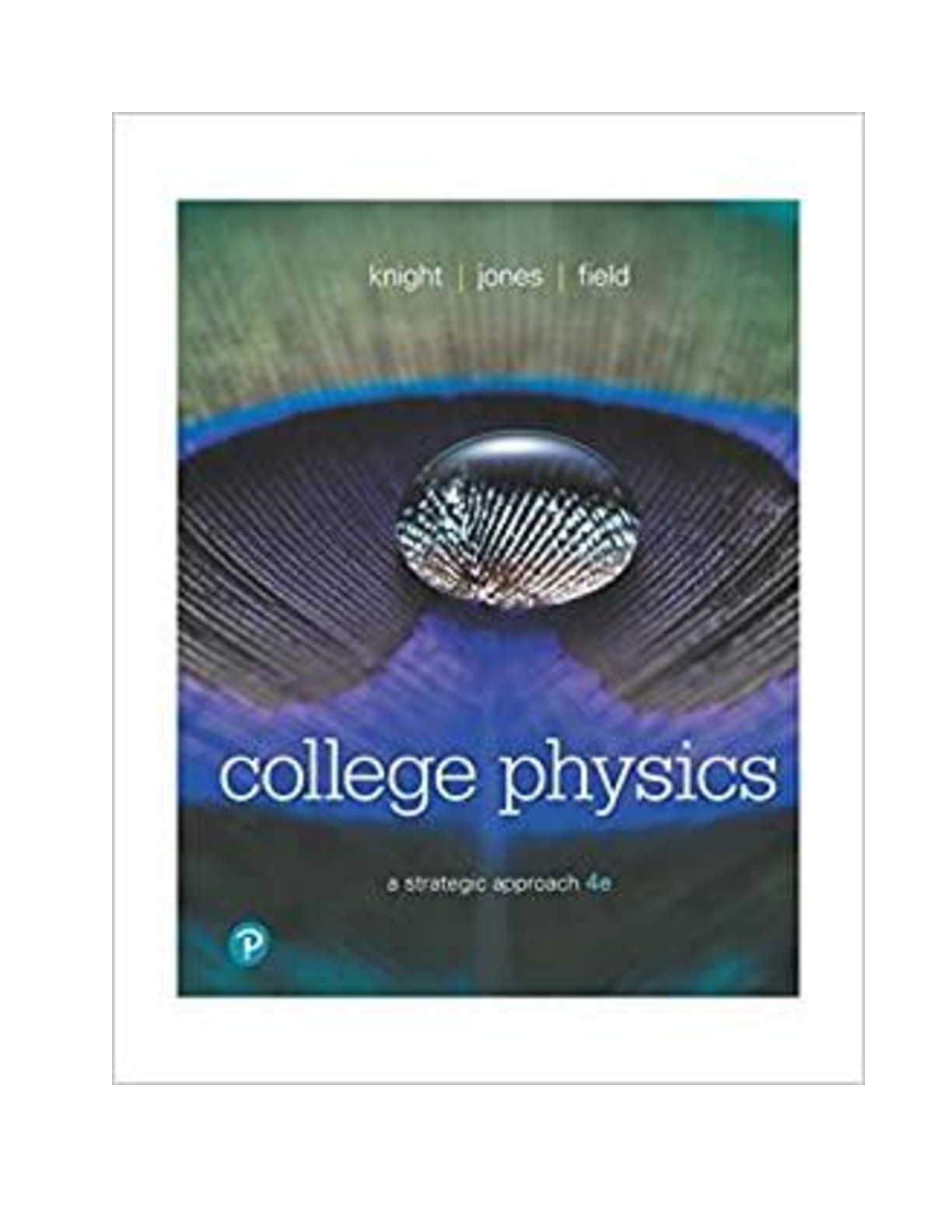
Buy this document to get the full access instantly
Instant Download Access after purchase
Add to cartInstant download
Reviews( 0 )
Document information
Connected school, study & course
About the document
Uploaded On
Oct 06, 2021
Number of pages
1160
Written in
Additional information
This document has been written for:
Uploaded
Oct 06, 2021
Downloads
0
Views
63



 Strategic Management Creating Competitive Advantages, 10e Gregory Dess, Gerry McNamara, Alan Eisner, Seung-Hyun Lee.png)
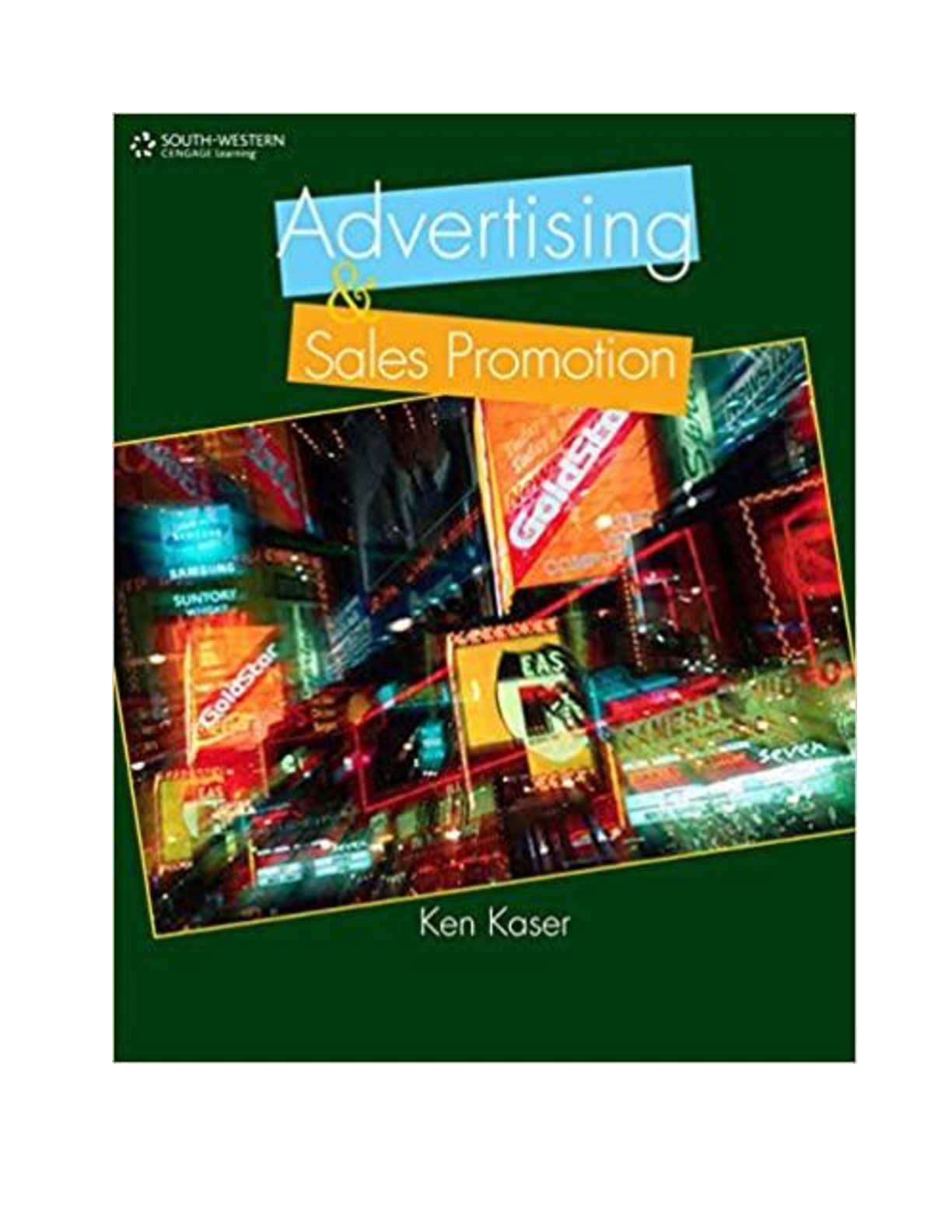


 Gary Donell, Clarence Byrd, Ida Chen.png)



